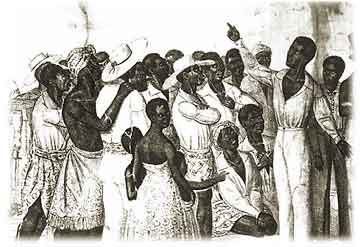 |
Yale AbolitionistsYale
Abolitionists |
The Amistad Affair
A few years after the "Negro college" incident, Simeon Jocelyn, Arthur Tappan, and Roger Sherman Baldwin found themselves back together again, advocating for racial justice in the case of the Amistad captives. The captives were a group of West Africans who had been kidnapped and sold into slavery in Cuba, had mutinied, and gained control of their vessel. In their attempt to return to Africa, they were re-captured and jailed in New Haven in 1839. This time, however, Baldwin and Jocelyn did not face hundreds of hostile neighbors all alone. During the Amistad trial, public sympathy was kindled, and the captives were freed. Much has been written about the Amistad event-Steven Spielberg has produced a feature-length film, and a replica of the ship has been rebuilt and docked in New Haven. The most prominent Yale faculty member to help the Amistad captives was Josiah W. Gibbs. A Philology Professor at Yale's Theological department, Prof. Gibbs helped to translate the Mende language of the African captives, which allowed them to testify on their own behalf during the trial. Two other Yale faculty-Rev. George Day and Rev. Leonard Bacon-helped to educate and evangelize the Amistad captives while they were in jail. No building on the Yale campus honors the Josiah Gibbs of Amistad fame. (142) There is a "Bacon" wing of the Yale Divinity School. The original lawyers on both sides of the Amistad case were all Yale graduates. The two lawyers who represented the Spanish Crown, arguing that the Amistad captives were slaves who had mutinously murdered their own owners, were:
The lawyers who represented the Amistad captives, arguing for freedom, were:
Once the Amistad case went before the U. S. Supreme Court, former U.S. President John Quincy Adams replaced Staples and Sedgewick as the captives' representative. The Amistad captives won their freedom, and money was raised to send them back to Africa. The commitment to colonization as a solution to slavery can help explain why the return of the Amistad captives to Africa garnered support, while the "Negro college" did not. Abolitionists supported the end of the slave trade. The more conservative colonizationists supported sending all black people to Africa (143). In the case of the Amistad, the captives in question were bona fide Africans, rather than African-Americans. Hence, the Amistad rebellion suggested a solution that both abolitionists and colonizationists could support: Send the black captives back to Africa.
|
|
